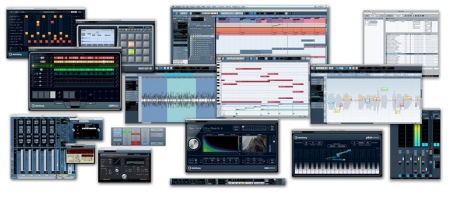
We understand that the Soundcard market can be a little daunting if you don’t know exactly what you are looking for. With various connection methods such as USB, Firewire, and PCI it is difficult to find the one for you.
This guide should give you an overview of the world of soundcards and hopefully help you someway in choosing the right one for you. Please remember that you can always call us if you ever need help or advice on 0844 815 0888.
The difference you find with soundcards to mixers is that where as a mixer will just take an analogue signal and keep it as analogue. A soundcard converts the analogue to digital. The price of soundcards can sometimes be determined by the quality of the AD converters and mic pre amps. For example the quality of the RME AD converters is better then the ones found on the M Audio soundcard range, although how much better is negotiable.
Tascam US122 M
Will the soundcard on my computer not suffice?
Whenever a customer questions this at Dolphin our response is always to let them try it out first with the onboard soundcard. There is no better way of learning how much of a difference good AD converters can be then to use really bad ones. The onboard soundcard (or internal soundcard) is installed for alert sounds, games and MP3s but when it comes to recording audio and transferring to digital you really do need a better soundcard. Interference from the transformer, hard drive and so on will always inhibit the quality
On board soundcards don’t offer multiple inputs which rules out any larger scale recording of bands or primarily drums. They also suffer from large amounts of latency (glitches in the audio recording) which you will need to overcome via getting a better soundcard. This latency is caused by the onboard drivers not being capable of fast transfer speeds. You really need something with ASIO 2 drivers, which most external soundcards support
Focusrite Saffire Pro 24
How Many Inputs and Outputs do I need?
In today’s market there is a soundcard for everybody. We always ask customers to think into the future. Will there ever be a time that you will want to record more than two inputs simultaneously. This might be drums, a live recording, a band or the fact that they will have many instruments and don’t want to keep plugging and unplugging cables. If the answer is yes then we recommend 8 inputs. Unless you have a specific reason we would recommend that you have all 8 inputs via XLR and mic pre amps. You may not want this if you are using your own Pre Amps or you specifically need jacks.

M-Audio ProFire 2626 High-Definition FireWire Audio Interface
If your music work will mainly be you and overdubbing other parts later, you can work happily with one or two inputs which is how a large amount of souncards are designed. Many people realise that they only need two inputs and if that is the case there are many options for you. Solutions range from just a small box that you connect to your computer, MIDI keyboards with soundcards built in (for the musician on the move) to guitar FX modeling solutions that you can connect straight to your computer. More and more manufacturers are seeing the need for combining an audio recording solution with their products.
Do I need a special Soundcard to use Pro Tools?
In a nutshell “Yes”. DigiDesign software will only work with Digi Design hardware. They obviously do very expensive HD systems for the medium to large studios, but they also have a more budget range of audio recording solutions. They have the Digi 002 and rack version for someone who wants 8 simultaneous inputs into ProTools. Anyone just wanting 2 inputs they have the ever popular MBOX and new MBOX Pro.
Digi Design has recently bought M Audio, a smaller company that specialises in soundcards. Since doing this they have allowed users to run Pro Tools on M Audio soundcards. To do this you must purchase software called M Powered and have a soundcard that is compatible and you have a Pro Tools system.
Soundcard Connectivity with Computers
The ever popular question about what connection you should go for is asked by customers every day at Dolphin Music. Firewire is probably the most popular type as of today due to its fast data transfer speed, you will find that M Audio firewire interfaces as well as Presonus are very good. USB 2.0 which is actually slightly faster is also popular with the Mbox 2 Micro , Steinberg CI2 and Apogee ONE using it.
Back in the last century when we started all this USB and Firewire were but a twinkle in some technician’s eye. It was all about PCI cards which are going as string today as they have done. PCI (or PCIX – new versions) can offer faster data transfer but are also more processor dependent. Famous PCI soundcards are the likes of the M Audio Delta range and the older MOTU range of soundcards.
It would be rude to talk about connectivity and not mention PCMCIA. This is a method of connecting directly to laptops. Just think PCI for laptops. Due to USB and Firewire it is becoming less popular but some still believe it to be the only true way of getting true recordings onto laptops. This is debatable and we just don’t have the time!
Free Software
All soundcards will come with software that will allow you to control the routing of audio within your soundcard. You will need this software to interface with your recording software. It basically allows you to interface with your soundcard as if it were a mixing console.

























 XP Tweaks For Music (
XP Tweaks For Music (








